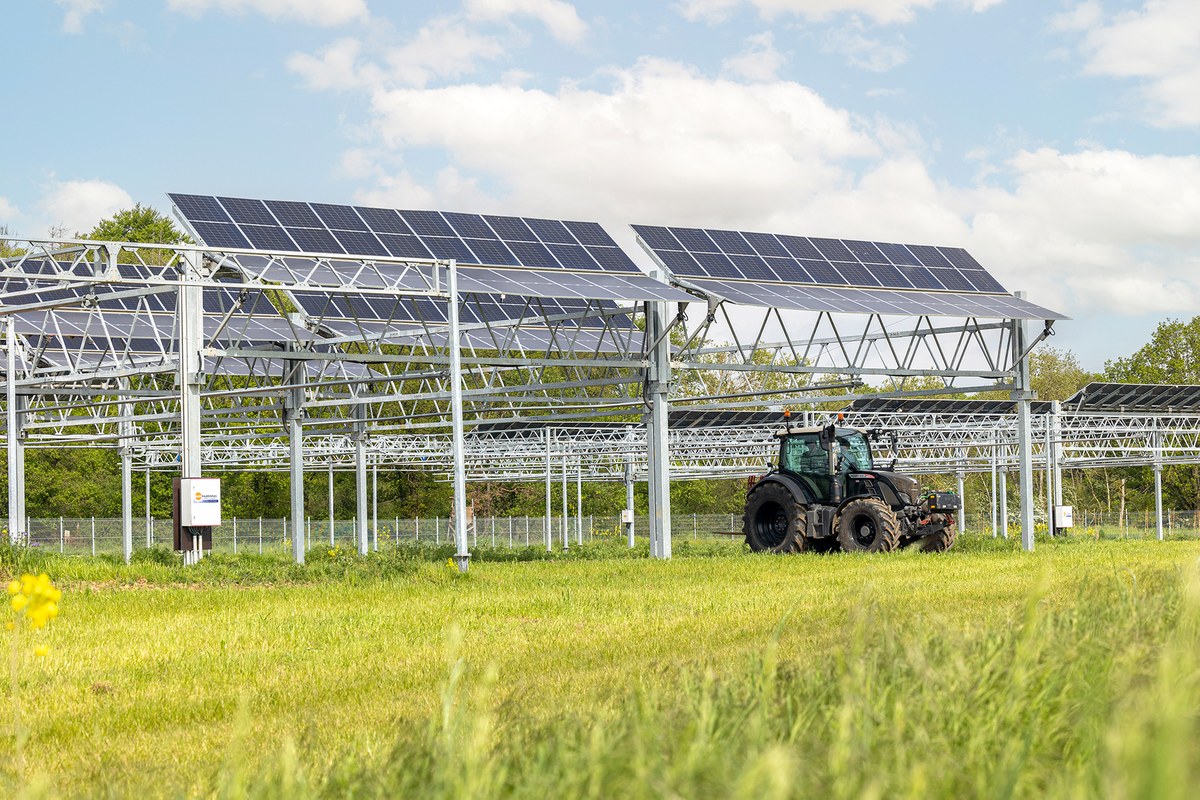24 November 2025
What are the benefits of placing solar panels over agricultural land? Where do they make sense, and who is already using them today? An international team, including researchers from Forschungszentrum Jülich, has investigated these and other questions and summarized the current state of agrivoltaics research in a new review article published in Nature Reviews Clean Technology. We asked Dr. Onno Muller and Dr. Matthias Meier-Grüll from Jülich's Institute of Bio- and Geosciences - Plant Sciences about the technology's global potential and the hurdles that still need to be overcome.

What exactly is agrivoltaics and what benefits does it offer?
Agrivoltaics refers to the combined use of agricultural land for crop production and photovoltaics. The modules are integrated into farming activities so that agriculture and energy production can take place in parallel. Our paper shows that global interest in this dual use of land is growing rapidly, as it not only provides renewable energy but also offers solutions to challenges such as climate adaptation and land-use conflicts.
A key advantage is the additional and more stable source of income: harvest plus electricity. The land equivalent ratio (LER), which measures the combined crop and energy yield relative to separate land uses, is often positive because agricultural and PV yields complement each other. Put simply, if the combined use produces more per unit area than two separate areas for crops and PV, the LER is above 1, and agrivoltaics is worthwhile.
There are also agronomic benefits. The partial shading effects of the modules can protect plants from heat and drought stress, thus increasing the resilience of crops, especially in warmer regions. At the same time, a slightly altered microclimate is created under the modules: the air and soil remain somewhat cooler and more humid, so that less water evaporates - an effect that can reduce the need for irrigation. And there are also crops, such as raspberries, that have been shown to benefit from this moderate shading. Taken together, these factors mean that agrivoltaics can help stabilize agricultural yields in the long term, even as climate conditions continue to change
Where are agrivoltaic systems already in use - and where is their use particularly worthwhile?
At the moment, agrivoltaics is primarily used in countries with high electricity prices, since this creates the greatest economic benefit. Interestingly, these are not always the regions with the best solar energy conditions. The models presented in the paper show, for instance, that the Mediterranean regions are particularly well suited for agrivoltaics due to a combination of high solar radiation and favourable growing conditions. In Western Europe, by contrast, conditions are more complex, because many crops require more light and overall solar radiation is lower. This makes it all the more important to adapt the system design to local conditions - for example through the right module height, suitable spacing between rows, or by choosing crops that cope well with partial shading. In this way, agricultural and energy yields can be optimally aligned.
How great is the theoretical potential - and how can agrivoltaics contribute to the energy transition?
The Fraunhofer Institute in Freiburg has calculated that around 10 % of German agricultural land would be technically suitable for agrivoltaics, and that, in theory, around 1.7 TW of PV capacity could be installed. To meet national climate targets, a total of 500 gigawatts of PV capacity will be needed by 2040. This can be provided on all available surfaces - for example, roofs, facades, car parks, infrastructure areas, and conventional open-field PV installations. Agrivoltaics is an important component in the overall mix. We believe the potential lies where agrivoltaics offers ecological benefits and stabilizes yields. This then only applies to around 1-2 % of all agricultural land in Germany that is realistically suitable for the expansion of agrivoltaics. That would correspond to an installed agrivoltaic capacity of 170 to 340 gigawatts, which could contribute significantly to Germany PV electricity by 2040.
What hurdles are there - and how is Forschungszentrum Jülich advancing the technology?
The main challenges include higher investment costs compared to conventional PV systems, a lack of uniform standards, and very different regulations and levels of acceptance from region to region. To overcome these hurdles, the team from Jülich is active on several fronts. On the one hand, we are demonstrating a variety of agrivoltaic setups in the region, where we work with partners in the field to test how technology, crops, and cultivation behave under real conditions. On the other hand, we combine agrivoltaics with our expertise in plant phenotyping. This allows us to examine very precisely how plants react to the altered light and microclimate conditions - knowledge that helps both the science community and users to select and further develop suitable systems.
Finally, we also support the creation of reliable regulatory frameworks. One key step is the development of the existing DIN SPEC 91434, a preliminary version of a DIN standard currently in a trial phase, into a full standard. In Germany, this standard specifies how agrivoltaic systems must be constructed and what approval authorities need to consider for new projects. Such standards ensure planning security - for farmers as well as investors and authorities - and help to implement projects more quickly and reliably.
Different terms - same meaning
In Germany, the term most commonly used is Agri-PV or APV, in France it is agrivoltaism, and in Japan - where the technology has a particularly long tradition - it is called solar sharing. In all cases, the principle is the same: the combined use of agriculture and photovoltaics.
Original Publication
Pietro E. Campana, Jordan Macknick, Michele Croci, Mohamed R. Elkadeem, Shiva Gorjian, Alexis Pascaris, Rosa I. Cuppari, Stefano Amaducci, Wen Liu, Max Trommsdorff, Matthew A. Sturchio, Onno Muller, Alessandro Agostini, Anatoli Chatzipanagi, Alessandra Scognamiglio & Jie Zhang. Scientific frontiers of agrivoltaic cropping systems. Nature Reviews Clean Technology 1, pages 801-821 (2025). https://doi.org/10.1038/s44359-025-00110-9






